

What Is This Thing Called Design? The GV research sprint: a 4-day process for answering important startup questions. Field Guide to UX Research for Startups. Five Models for Making Sense of Complex Systems – Christina Wodtke. My new book on visual thinking is out!

In one of the classes I teach at CCA, students were confused by mental models, conceptual models, concept maps, etc. I ended up drawing a taxonomy for models on the whiteboard, and it may help others. This post is for them first, then you! Admittedly, there is no worldwide agreement on these terms, because humans make things and name them as they see fit, often without searching for previous work. Validating Product Ideas. Amazingly, 198 out of the 200 enterprise product managers and startup founders interviewed for this book said they were keeping a list of product ideas they wanted to make a reality some day.
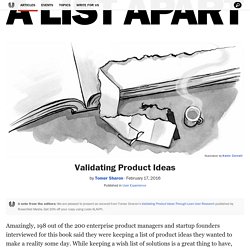
While keeping a wish list of solutions is a great thing to have, even more impressive is what only two startup founders were doing. These founders were keeping a list of problems they wanted to solve. They chose to first fall in love with a problem rather than a solution. The Evolution of UX Process Methodology. The 9 Rules of Design Research – Mule Design Studio. Lately, I’ve noticed a lot more ambient enthusiasm for research among both early stage start-ups and established organizations.
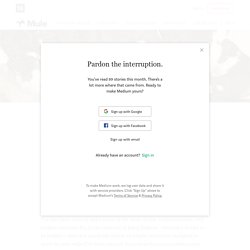
Businesses have embraced the idea that meaningful innovation requires understanding their customers as humans with complex lives. This is fantastic. I’ve also been hearing quite a few of the same myths, misperceptions, and hedges repeated. So, in the interests of being helpful—because I do like to be helpful—here is a snackable listicle of simple correctives designed to share far and wide (I’ve been assured that research proves readers enjoy snackable listicles. And puppies.) 1. What Is User Experience Design? Overview, Tools And Resources. Advertisement Today, too many websites are still inaccessible.
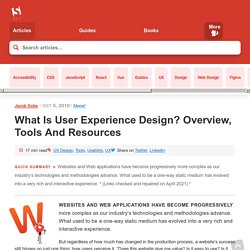
In our new book Inclusive Design Patterns, we explore how to craft flexible front-end design patterns and make future-proof and accessible interfaces without extra effort. Hardcover, 312 pages. Get the book now! Creating an Agile Road Map Using Story Mapping. We know that a prioritized backlog helps us understand what to do next, but sometimes it's difficult to grasp where we are and where we should go -- especially if we just dive into a big project that's been started, with hundreds of stories and/or issues already created.

To solve these situations, I have found it very useful to manage the road map and backlog with the help of a story map. How to create a User Story Map. User story mapping is becoming a popular technique through the efforts of Jeff Patton and others that allows you to add a second dimension to your backlog.
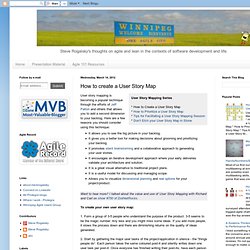
Here are a few reasons you should consider using this technique: It allows you to see the big picture in your backlog.It gives you a better tool for making decisions about grooming and prioritizing your backlog. It promotes silent brainstorming and a collaborative approach to generating your user stories.It encourages an iterative development approach where your early deliveries validate your architecture and solution.It is a great visual alternative to traditional project plans.It is a useful model for discussing and managing scope.Allows you to visualize dimensional planning and real options for your project/product.
Creating a lean, mean product requirements machine. Summary: A product requirements document (PRD) defines the requirements of a particular product, including the product’s purpose, features, functionality, and behavior.
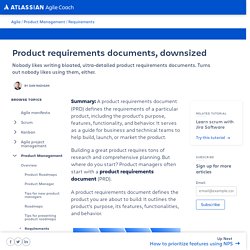
It serves as a guide for business and technical teams to help build, launch, or market the product. Building a great product requires tons of research and comprehensive planning. But where do you start? User stories: a beginner's guide to acceptance criteria. By courtney in Agile on September 22, 2010 Last week I described the bones of the user story in the first post of our introductory series on user stories.
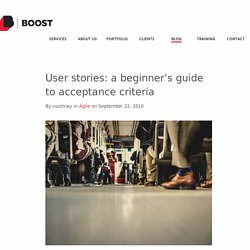
Briefly, a user story is a description of an objective a person should be able to achieve when using your website/application/software, written in the following format: As an [actor] I want [action] so that [achievement]. For example: As a Flickr member I want to be able to assign different privacy levels to my photos so I can control who I share which photos with. This post adds some flesh to the idea of user stories, in the shape of acceptance criteria.
Where are the details? Write a Great User Story. What is a user story?

A user story represents a small piece of business value that a team can deliver in an iteration. While traditional requirements (like use cases) try to be as detailed as possible, a user story is defined incrementally, in three stages: The brief description of the need The conversations that happen during backlog grooming and iteration planning to solidify the details The tests that confirm the story's satisfactory completion Well-formed stories will meet the criteria of Bill Wake's INVEST acronym: Effective Samples and Tips. 10 Tips for Writing Good User Stories. User stories are probably the most popular agile technique to capture product functionality: Working with user stories is easy.

But telling effective stories can be hard. The following ten tips help you create good stories. 1 Users Come First. Business Requirements vs. Functional Requirements - Enfocus Solutions Inc. Many analysts struggle with understanding the differences between business requirements and functional requirements. Some people even think they are the same, but I want to assure you that they are not. In this blog, I explain the differences. To be clear, in defining requirements, there are actually four types of requirements that should be defined: business requirements, stakeholder requirements, solution requirements, and transition requirements.
2018 Is the Year of the Intangibles – BRIGHT Magazine. Designing Better Design Documentation. 1. Adding a summary Let’s say, you’ve made a profound heuristic evaluation of client’s application and pointed out a hundred of usability issues. The Lean UX Manifesto: Principle-Driven Design — Smashing Magazine. How to Stop UX Research being a Blocker. Minimum viable skills in UX. The effective minimum designers need to know to create a project or find a job. New designers can be intimidated by the amount of tools and techniques considered must-have. Are these tools equally important? GuidetoNudging Rotman Mar2013. Tools for taking action. — Stanford d.school. Are You Solving the Right Problems? How good is your company at problem solving? Probably quite good, if your managers are like those at the companies I’ve studied. What they struggle with, it turns out, is not solving problems but figuring out what the problems are.
In surveys of 106 C-suite executives who represented 91 private and public-sector companies in 17 countries, I found that a full 85% strongly agreed or agreed that their organizations were bad at problem diagnosis, and 87% strongly agreed or agreed that this flaw carried significant costs. Fewer than one in 10 said they were unaffected by the issue. The pattern is clear: Spurred by a penchant for action, managers tend to switch quickly into solution mode without checking whether they really understand the problem.
It has been 40 years since Mihaly Csikszentmihalyi and Jacob Getzels empirically demonstrated the central role of problem framing in creativity. Part of the reason is that we tend to overengineer the diagnostic process. The Slow Elevator Problem 1. Developing Your Interviewing Skills, Part I: Preparing for an Interview. Sometimes when we have a poor interview, we blame the person we’ve interviewed. That person might be a design stakeholder or current or potential customer. You might be conducting behavioral or stakeholder interviews or running usability test sessions. The interviews may have been at participants’ offices or homes, in your offices, or in the field.
Regardless of the situation, you may be tempted to label a participant unengaged, inappropriate, inarticulate, or worse. Lean UX: Getting Out Of The Deliverables Business. User experience design for the Web (and its siblings, interaction design, UI design, et al) has traditionally been a deliverables-based practice. Wireframes, site maps, flow diagrams, content inventories, taxonomies, mockups and the ever-sacred specifications document (aka “The Spec”) helped define the practice in its infancy. Cynefin for Designers – 13 Antipatterns – Medium.
Rapid Prototyping 1 of 3: Sketching & Paper Prototyping. UX is UI – Mike Atherton – Medium. A meme can travel halfway around the world while nuance is putting on its shoes. Ideas bounce around the Twitters, endorsed and adopted wholeheartedly through fear, surprise, or a fanatical dedication to the church of UX. Mobile-first, responsive over m-dot, prototypes over wireframes. These truths we hold to be self-evident. Complex and contextual ideas, reduced to tweetable dogma. Experience Design at Hello Erik. Sprint: Monday. Graphic design legend Milton Glaser dispels a universal misunderstanding of design and art — Quartz. Design Thinking 101. Design Doesn’t Scale. Design Doesn’t Scale. Measuring Task Times without Users: MeasuringU. Jeff Sauro • January 4, 2011. Systems Thinking: A Product Is More Than the Product. UX Project Checklist. 8 habits of veteran UX designers. One of the fables that floats around UX teams is that of the US space program and its quest for a pen that could be used in anti-gravity.
They reportedly spent million dollars developing a high-tech writing utensil with ink that remained solid until the flow of writing and a pressurized chamber that made it useful upside-down. The Russian cosmonauts, however, simply brought pencils. Though this story isn’t wholly true, it shines light on the necessity of understanding the larger picture. The space pen did make it into orbit and was a privately-funded accomplishment in engineering. 3 ways to strengthen your discovery phase.
How to conquer designer’s block. Continuum – ‘Live Labs': Prototyping Environments to Measure Customer Experience. Making it Real. This is Service Design Thinking. Design Kit. The importance of prototyping: Creative Confidence by Tom and David Kelley. 6 key insights on UX design. Three Ways To Reframe A Problem To Find An Innovative Solution. Don't Build When You Build-Measure-Learn. The Design Process: A Pyramid. Design researchers must think fast and slow.
The product design sprint: setting the stage. Making Good Design Decisions. #23 – How to run a design critique. Matching a Designer to the Right Project — The Year of the Looking Glass. 6 Steps for Measuring Success on UX Projects. Measuring Usability Calculators. In Defense Of A/B Testing - Smashing Magazine. Statistical significance & other A/B pitfalls — Cennydd Bowles. When to Use Which User Experience Research Methods. Testing Content. » Customer Development Interviews How-to: What You Should Be Learning. Startup Lab workshop: User Research, Quick 'n' Dirty.
A Five-Step Process For Conducting User Research. How to find great participants for your user study. Ethnography Fieldguide - Helsinki Design Lab. Replacing The User Story With The Job Story — Jobs To Be Done. Minimum Viable Product vs. Minimum Delightful Product. A shorthand for designing UI flows by Ryan of Basecamp. UX Crash Course: 31 Fundamentals.